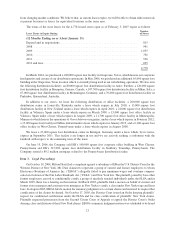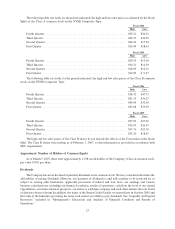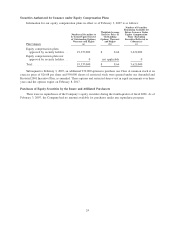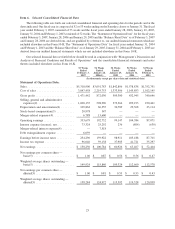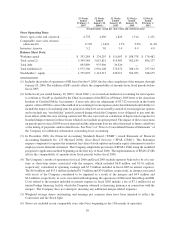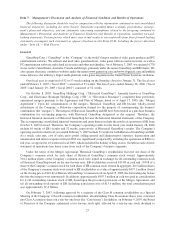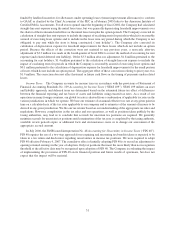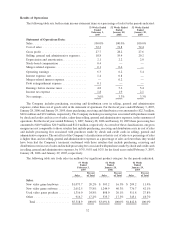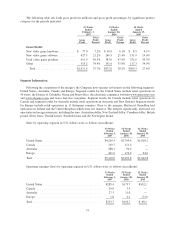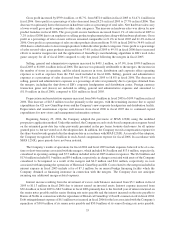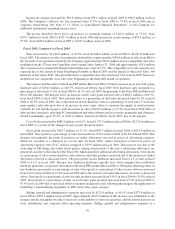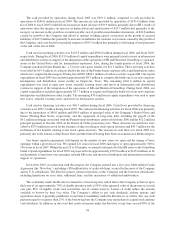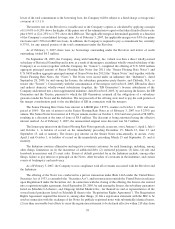GameStop 2006 Annual Report Download - page 45
Download and view the complete annual report
Please find page 45 of the 2006 GameStop annual report below. You can navigate through the pages in the report by either clicking on the pages listed below, or by using the keyword search tool below to find specific information within the annual report.connection with the mergers. Goodwill in the amount of $8.1 million was recorded in the acquisition in January
2007 of Game Brands Inc. (operating as Rhino Video Games stores).
Goodwill represents the excess purchase price over tangible net assets and identifiable intangible assets
acquired. The Company evaluates goodwill for impairment on at least an annual basis. In accordance with the
requirements of Statement of Financial Accounting Standards No. 142, Goodwill and Other Intangible Assets
(“SFAS 142”), the Company completed annual impairment tests of the goodwill attributable to its reporting unit as
of the first day of the fourth quarter of fiscal 2004 and concluded that none of its goodwill was impaired. Until
October 8, 2005, the date of the mergers, the Company determined that it had one reporting unit based upon the
similar economic characteristics of its operations. Fair value of this reporting unit was estimated using market
capitalization methodologies. Subsequent to the mergers, the Company determined that it has four reporting units,
the United States, Australia, Canada and Europe, based upon the similar economic characteristics of operations and
separate management within those regions. The Company employed the services of an independent valuation
specialist to assist in the allocation of goodwill resulting from the mergers to the four reporting units as of October 8,
2005. The Company also completed its annual impairment test of goodwill as of the first day of the fourth quarter of
fiscal 2005 and fiscal 2006 and concluded that none of its goodwill was impaired. Note 7 of “Notes to Consolidated
Financial Statements” of the Company provides additional information concerning goodwill.
Intangible Assets and Other Noncurrent Assets. Intangible assets consist of non-compete agreements,
point-of-sale software and amounts attributed to favorable leasehold interests acquired in the mergers and are
included in other non-current assets in the consolidated balance sheet. The total weighted-average amortization
period for the intangible assets, excluding goodwill, is approximately four years. The intangible assets are being
amortized based upon the pattern in which the economic benefits of the intangible assets are being utilized, with no
expected residual value.
The deferred financing fees associated with the Company’s revolving credit facility and the senior notes and
senior floating rate notes issued in connection with the financing of the mergers are separately shown in the
consolidated balance sheet. The deferred financing fees are being amortized over five, six and seven years to match
the terms of the revolving credit facility, the senior floating rate notes and the senior notes, respectively.
Cash Consideration Received from Vendors. The Company and its vendors participate in cooperative
advertising programs and other vendor marketing programs in which the vendors provide the Company with
cash consideration in exchange for marketing and advertising the vendors’ products. Our accounting for cooperative
advertising arrangements and other vendor marketing programs, in accordance with FASB Emerging Issues Task
Force Issue 02-16 or “EITF 02-16,” results in a portion of the consideration received from our vendors reducing the
product costs in inventory. The consideration serving as a reduction in inventory is recognized in cost of sales as
inventory is sold. The amount of vendor allowances recorded as a reduction of inventory is determined by
calculating the ratio of vendor allowances in excess of specific, incremental and identifiable advertising and
promotional costs to merchandise purchases. The Company then applies this ratio to the value of inventory in
determining the amount of vendor reimbursements recorded as a reduction to inventory reflected on the balance
sheet. Because of the variability in the timing of our advertising and marketing programs throughout the year, the
Company uses significant estimates in determining the amount of vendor allowances recorded as a reduction of
inventory in interim periods, including estimates of full year vendor allowances, specific, incremental and
identifiable advertising and promotional costs, merchandise purchases and value of inventory. Estimates of full
year vendor allowances and the value of inventory are dependent upon estimates of full year merchandise purchases.
Determining the amount of vendor allowances recorded as a reduction of inventory at the end of the fiscal year no
longer requires the use of estimates as all vendor allowances, specific, incremental and identifiable advertising and
promotional costs, merchandise purchases and value of inventory are known.
Although management considers its advertising and marketing programs to be effective, we do not believe that
we would be able to incur the same level of advertising expenditures if the vendors decreased or discontinued their
allowances. In addition, management believes that the Company’s revenues would be adversely affected if its
vendors decreased or discontinued their allowances, but management is unable to quantify the impact.
Lease Accounting. As previously disclosed, in fiscal 2004, the Company, similar to many other retailers,
revised its method of accounting for rent expense (and related deferred rent liability) and leasehold improvements
30



